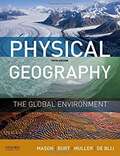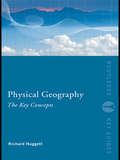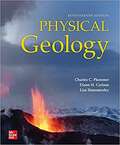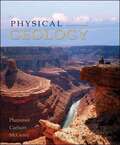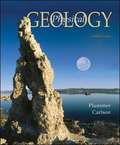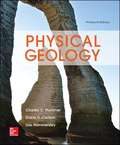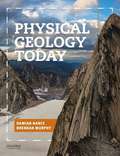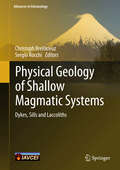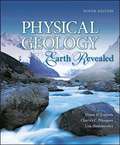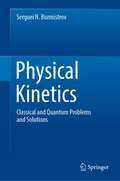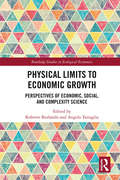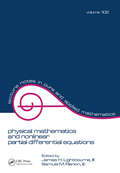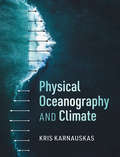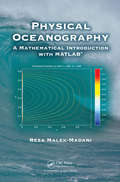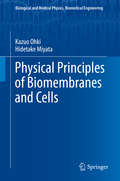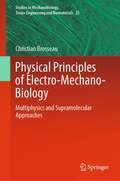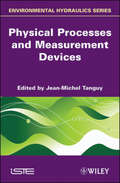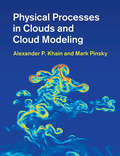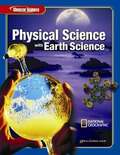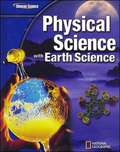- Table View
- List View
Physical Geography: The Global Environment
by Harm De Blij Peter Muller Joseph Mason Jason BurtWell known for its flexibility, clarity of presentation, and graphic excellence, Physical Geography: The Global Environment, Fifth Edition, provides a thorough, scientifically authoritative, accessible, and geographic view of Earth's physical systems.
Physical Geography: The Key Concepts (Routledge Key Guides)
by Richard John HuggettPhysical Geography: The Key Concepts is a thought-provoking and up-to-date introduction to the central ideas and debates within the field. It provides extended definitions of terms that are fundamental to physical geography and its many branches, covering topics such as: biogeography ecology climatology meteorology geomorphology hydrology pedology Complete with informative tables, diagrams, and suggestions for further reading, this is a highly accessible guide for those studying physical geography and related courses.
Physical Geology
by Charles C. Plummer Diane H. Carlson Lisa HammersleyPhysical Geologyis a classic introductory text that has helped countless students learn basic physical geology concepts for over 25 years. Students taking introductory physical geology to fulfill a science elective, as well as those contemplating a career in geology, will appreciate the accessible writing style and depth of coverage in Physical Geology.
Physical Geology
by Charles Plummer Diane Carlson David McGearyContains hundreds of illustrations and accompanying photographs which correlate with the chapter descriptions to help readers grasp new geologic concepts. This book also accompanies numerous chapter learning tools and a rich Online Learning Center website which further assist students in their study of physical geology.
Physical Geology (12th Edition)
by Charles C. Plummer Diane H. CarlsonOne excellent reason to read this book is that it's tried and true. Since the book was published in 1979, over 1,000,000 students have read this text as an introduction to physical geology. Proportionately, geology instructors have relied on this text for over 5,000 courses to explain, illustrate, and exemplify basic geologic concepts to both majors and non-majors. Today, the 12th edition continues to provide contemporary perspectives that reflect current research, recent natural disasters, unmatched illustrations, and unparalleled learning aids. We have worked closely with contributors, reviewers, and our editors to publish the most accurate and current text possible.
Physical Geology (Fifteenth Edition)
by Charles C. Plummer Diane H. Carlson Lisa HammersleyPhysical Geology, 15th edition, is the latest refinement of a classic introductory text that has helped countless students learn basic physical geology concepts for over 25 years. Students taking introductory physical geology to fulfill a science elective, as well as those contemplating a career in geology, will appreciate the accessible writing style and depth of coverage in Physical Geology. Hundreds of carefully rendered illustrations and accompanying photographs correlate perfectly with the chapter descriptions to help readers quickly grasp new geologic concepts. Numerous chapter learning tools and a website further assist students in their study of physical geology.
Physical Geology (Fifteenth Edition)
by Charles C. Plummer Diane H. Carlson Lisa HammersleyPhysical Geology, 15th edition, is the latest refinement of a classic introductory text that has helped countless students learn basic physical geology concepts for over 25 years. Students taking introductory physical geology to fulfill a science elective, as well as those contemplating a career in geology, will appreciate the accessible writing style and depth of coverage in Physical Geology. Hundreds of carefully rendered illustrations and accompanying photographs correlate perfectly with the chapter descriptions to help readers quickly grasp new geologic concepts. Numerous chapter learning tools and a website further assist students in their study of physical geology.
Physical Geology Today
by Damian Nance Brendan MurphyPhysical Geology Today combines a deep integration of plate tectonics with an emphasis on conceptual understanding in order to paint an integrated picture of how Earth works. Damian Nance and Brendan Murphy blend clear engaging prose with hundreds of meticulously crafted illustrations to tell a clear and accessible geologic story that introduces the right amount of terminology at the right time.
Physical Geology of Shallow Magmatic Systems: Dykes, Sills And Laccoliths (Advances In Volcanology Ser.)
by Christoph Breitkreuz Sergio RocchiThis book offers a high-level summary of shallow magmatic systems (dykes, sills and laccoliths) to support geoscience master and PhD students, scientists and practicing professionals. The product of the LASI (Laccoliths and Sills conference) workshop, it comprises thematic sections written by one or more experts on the respective field. It features reviews concerning the physical properties of magma, geotectonic settings, and the structure of subvolcanic systems, as well as case studies on the best-known systems. The book provides readers a broad and comprehensive understanding of the subvolcanic perspective on pluton growth, which is relevant for mineralogical processes as well as the genesis of mineral deposits.
Physical Geology: Earth Revealed, Ninth Edition
by Charles C. Plummer Diane H. Carlson Lisa HammersleyThe ninth edition has been updated to include the most current information from the various sub-disciplines that comprise physical geology. The book's purpose is to clearly present geologic processes so that students can understand the logic of scientific methods. This text features an outstanding art program and a proven, accessible writing style.
Physical Geology: Exploring the Earth (2nd edition)
by Reed Wicander James S. MonroeTextbook on physical geology
Physical Kinetics: Classical and Quantum Problems and Solutions
by Serguei N. BurmistrovThis book includes problems based on the material in the course of physical kinetics for the students of general and applied physics. It contains 60 problems with detailed solutions. The comments to the problems reflect the connection with the problems and methods of modern physical kinetics. A brief introduction gives the necessary information for solving and understanding the problems. The book is proposed for students and postgraduates studying the theoretical physics. The book is used as a supplement to the textbooks published on physical kinetics. The purpose of the book is to help students in training the practical skills and mastering the basic elements of physical kinetics. To understand the subject matter, it is sufficient to know the traditional courses of theoretical physics.
Physical Limits to Economic Growth: Perspectives of Economic, Social, and Complexity Science (Routledge Studies in Ecological Economics)
by Angelo Tartaglia Roberto BurlandoThe debate on the physical limits and constraints to the economic growth of globalized society is now widespread. This book explores the physical and economic aspects of the conflict between humans, with their thoughtless focus on growth through material production, and environmental constraints. In the context of the looming shortage of material resources and the latest science on climate change, Physical Limits to Economic Growth offers new insights which provide a broad and comprehensive picture of the conflict between humans and environmental constraints. The authors’ approach goes beyond the boundaries of specialized disciplines to explore climate change, resource depletion, technical innovation and the interactions between these within the socio-economic-institutional systems we live in. This volume looks at opportunities for rethinking these systems if we moved away from fossil fuel dependence, while considering the status of current mainstream economic thinking around this subject. Physical Limits to Economic Growth provides a genuine interdisciplinary examination of the physical limits to economic growth. It will be of interest to both students and academics in various disciplines in the areas of natural sciences, climate change and economics.
Physical Mathematics
by Kevin CahillUnique in its clarity, examples and range, Physical Mathematics explains as simply as possible the mathematics that graduate students and professional physicists need in their courses and research. The author illustrates the mathematics with numerous physical examples drawn from contemporary research. In addition to basic subjects such as linear algebra, Fourier analysis, complex variables, differential equations and Bessel functions, this textbook covers topics such as the singular-value decomposition, Lie algebras, the tensors and forms of general relativity, the central limit theorem and Kolmogorov test of statistics, the Monte Carlo methods of experimental and theoretical physics, the renormalization group of condensed-matter physics and the functional derivatives and Feynman path integrals of quantum field theory.
Physical Mathematics and Nonlinear Partial Differential Equations
by James H. LightbourneThis volume consists of the proceedings of the conference on Physical Mathematics and Nonlinear Partial Differential Equations held at West Virginia University in Morgantown. It describes some work dealing with weak limits of solutions to nonlinear systems of partial differential equations.
Physical Oceanography and Climate
by Kris KarnauskasClimate research over recent decades has shown that the interaction between the ocean and atmosphere drives the global climate system. This engaging and accessible textbook focuses on climate dynamics from the perspective of the upper ocean, and specifically on the interaction between the atmosphere and ocean. It describes the fundamental physics and dynamics governing the behavior of the ocean, and how it interacts with the atmosphere, giving rise to natural climate variability and influencing climate change. Including end-of-chapter questions and turn-key access to online, research-quality data sets, the book allows readers the chance to apply their knowledge and work with real data. Comprehensive information is also provided on the data sets used to produce the numerous illustrations, allowing students to dive deeper into the data themselves. Providing an accessible treatment of physical oceanography, it is perfect for intermediate-advanced students wishing to gain an interdisciplinary introduction to climate science and oceanography.
Physical Oceanography: A Mathematical Introduction with MATLAB (Advances in Applied Mathematics)
by Reza Malek-MadaniAccessible to advanced undergraduate students, Physical Oceanography: A Mathematical Introduction with MATLAB demonstrates how to use the basic tenets of multivariate calculus to derive the governing equations of fluid dynamics in a rotating frame. It also explains how to use linear algebra and partial differential equations (PDEs) to solve basic i
Physical Principles of Biomembranes and Cells (Biological and Medical Physics, Biomedical Engineering)
by Kazuo Ohki Hidetake MiyataThis book describes how biologically available free energy sources (ATP, chemical potential, and membrane potentials, among others) can be used to drive synthetic reactions, signaling in cells, and various types of motion such as membrane traffic, active transport, and cell locomotion. As such, it approaches the concept of the energy cycle of life on Earth from a physical point of view, covering topics ranging from an introduction to chemical evolution, to an examination of the catalytic activity of enzymes associated with the genome in Darwinian evolution. The author introduces the relationship between functions and physical properties in biomembranes, explaining the methods and equipment used in biophysics research to help researchers unravel the still-unsolved mysteries of life. The physical principles needed to understand the cellular functions are provided; these functions are associated with biomembranes and regulated by physical properties of the lipid bilayer such as membrane fluidity, phase transition, and phase separation, as shown in lipid rafts. Other key dynamic aspects of life (cell locomotion, cytoskeletal dynamics, and sensitivities of the cell to physical stimuli such as external forces and temperature) are also discussed. Lastly, readers will learn how life on Earth and its ecological system are maintained by solar energy, and be provided further information on the problems accompanying global warming.
Physical Principles of Electro-Mechano-Biology: Multiphysics and Supramolecular Approaches (Studies in Mechanobiology, Tissue Engineering and Biomaterials #25)
by Christian BrosseauThis book covers the recently developed understanding of Electro-Mechano-Biology (EMB) in which the focus is primarily on the couplings between the electric and mechanical fields. The emphasis lies on the analytical and computational aspects of EMB at the cellular level. The book is divided into two parts. In the first part, the author starts by defining and discussing the relevant basic aspects of the electrical and mechanical properties of cell membranes. He provides an overview of some of the ways analytical modelling of cell membrane electrodeformation (ED) and electroporation (EP) appears in a variety of contexts as well as a contemporary account of recent developments in computational approaches that can feature in the theory initiative, particularly in its attempt to describe the cohort of activities currently underway. Intended to serve as an introductory text and aiming to facilitate the understanding of the field to non-experts, this part does not dwell on the set of topics, such as cellular mechanosensing and mechanotransduction, irreversible EP, and atomistic molecular dynamics modelling of membrane EP. The second (and larger) part of the book is devoted to a presentation of the necessary analytical and computational tools to illustrate the ideas behind EMB and illuminate physical insights. Brief notes on the history of EMB and its many applications describing the variety of ideas and approaches are also included. In this part, the background of the first principles and practical calculation methods are discussed to highlight aspects that cannot be found in a single volume.
Physical Processes and Measurement Devices: Environmental Hydraulics
by Jean-Michel TanguyThis series of five volumes proposes an integrated description of physical processes modeling used by scientific disciplines from meteorology to coastal morphodynamics. Volume 1 describes the physical processes and identifies the main measurement devices used to measure the main parameters that are indispensable to implement all these simulation tools. Volume 2 presents the different theories in an integrated approach: mathematical models as well as conceptual models, used by all disciplines to represent these processes. Volume 3 identifies the main numerical methods used in all these scientific fields to translate mathematical models into numerical tools. Volume 4 is composed of a series of case studies, dedicated to practical applications of these tools in engineering problems. To complete this presentation, volume 5 identifies and describes the modeling software in each discipline.
Physical Processes in Clouds and Cloud Modeling
by Alexander P. Khain Mark PinskyThis book presents the most comprehensive and systematic description currently available of both classical and novel theories of cloud processes, providing a much-needed link between cloud theory, observation, experimental results, and cloud modeling. This volume shows why and how modern models serve as a major tool of investigation of cloud processes responsible for atmospheric phenomena, including climate change. It systematically describes classical as well as recent advancements in cloud physics, including cloud-aerosol interaction; collisions of particles in turbulent clouds; and the formation of multiphase cloud particles. As the first of its kind to serve as a practical guide for using state-of-the-art numerical cloud models, major emphasis is placed on explaining how microphysical processes are treated in modern numerical cloud resolving models. The book will be a valuable resource for advanced students, researchers and numerical model designers in cloud physics, atmospheric science, meteorology, and environmental science.
Physical Science (South Carolina)
by Dinah Zike Charles William Mclaughlin Marilyn ThompsonGive every student a deeper understanding of physical science!. . Glencoe "Physical Science" integrates accurate and comprehensive coverage of physics and chemistry with mathematics through accessible text, engaging features, and a variety of hands-on experiences. The critical-thinking opportunities, real-world applications, and technology resources lead students to a deeper understanding of physical science, while building science process skills..
Physical Science with Earth Science
by Glencoe Mcgraw-HillPhysical Science with Earth provides students with accurate and comprehensive content coverage of physical science integrated with Earth science. This highly engaging integrated program brings together physics,chemistry, Earth science, space science, and mathematics. This course, together with a biology course, prepares students for many state/district graduation exams administered at 10th grade.
Physical Science with Earth Science
by National GeographicUnit 1: Science and Technology Unit 2: Motion, Forces and Energy Unit 3: Energy in Motion Unit 4: Forms of Energy Unit 5: Matter and Earth Materials Unit 6: Interactions of Matter
Physical Science: Concepts in Action
by Michael Wysession David Frank Sophia YancopoulosNIMAC-sourced textbook
